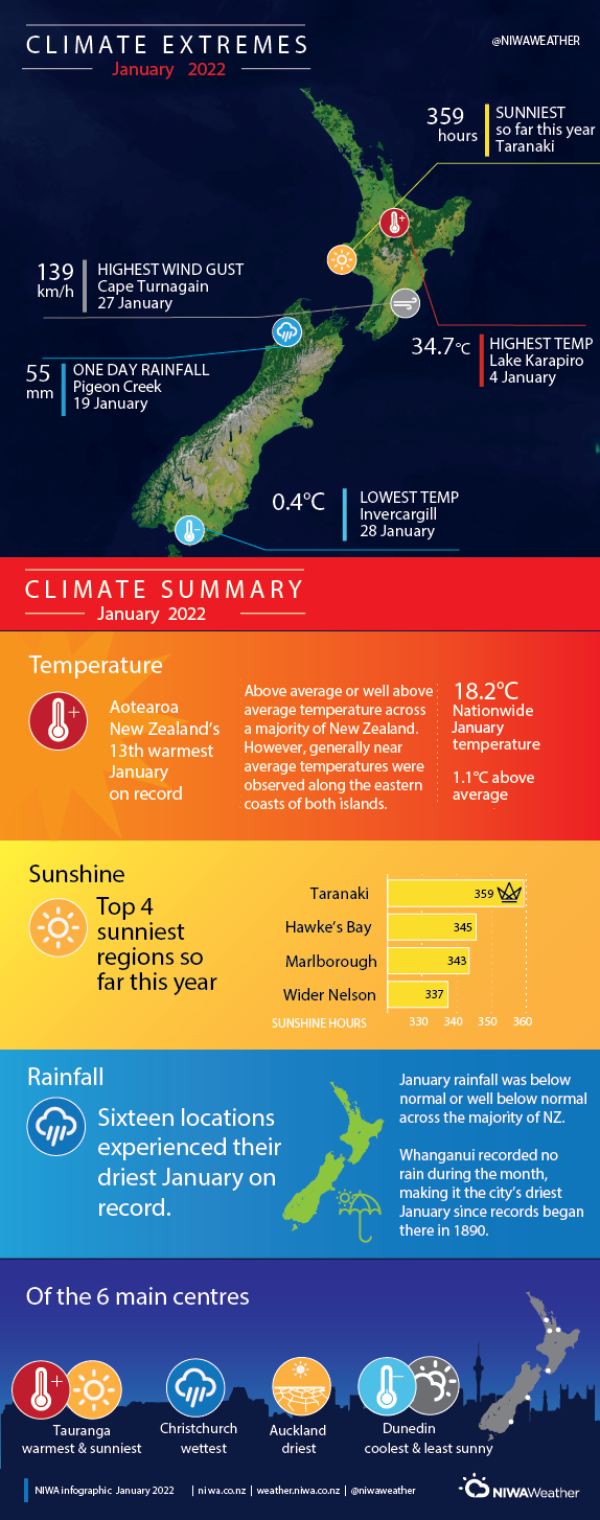A warm and very dry month for most locations.
|
Rainfall |
Below normal rainfall (50-79% of normal) or well below normal rainfall (<50% of normal) was observed across a vast majority of New Zealand, including nearly all of the North Island, along with the upper, western, and lower South Island. Isolated pockets of near normal rainfall (80-119% of normal) were observed in eastern Northland, coastal Gisborne, Mahia Peninsula, and parts of central and southern Canterbury. In addition, a small area of above normal rainfall (120-149% of normal) was observed near Kaikōura. |
|
Temperature |
Temperatures were above average (>0.50°C above average) or well above average (>1.20°C above average) across a majority of New Zealand. However, generally near average (±0.50°C of average) temperatures were observed along the eastern coasts of both islands, including coastal Gisborne, Hawke’s Bay, Wairarapa, Marlborough, and Canterbury. |
|
Soil Moisture |
At the end of January, soil moisture levels were lower than normal for the time of year across nearly all of the North Island, except coastal Gisborne where soil moisture was near normal. In the South Island, soil moisture levels were lower than normal in Nelson, Tasman, the West Coast, Otago, and Southland. Soil moisture levels were near normal in Marlborough Sounds and much of Canterbury, and above normal in far northern Canterbury. |
Overview
January 2022 mean sea level pressure was higher than normal over and southwest of Aotearoa New Zealand and lower than normal to the north of the country. This resulted in more easterly winds than normal. The presence of La Niña conditions in the tropical Pacific and plentiful high pressure in the New Zealand region helped to sustain a marine heatwave in New Zealand’s coastal waters during January, with sea temperatures 2-4°C above average at times. The month’s high pressure and easterly winds also resulted in plentiful sunshine across central and western New Zealand. In fact, New Plymouth set a new all-time monthly sunshine record for the country with 358.6 hours in January.
January rainfall was below normal (50-79% of normal) or well below normal (<50% of normal) across a vast majority of New Zealand, including nearly all of the North Island along with the upper, western, and lower South Island. This dryness was primarily caused by the plentiful high pressure over New Zealand during the month. Sixteen locations experienced their driest January on record, while Auckland endured a 37-day dry spell from 17 December 2021 to 22 January 2022, which was the city’s 2nd-longest dry spell since records began in 1943. In addition, a plethora of towns and cities around New Zealand instituted water restrictions during January. (see Highlights and extreme events section for more details).
January temperatures were above average (>0.50°C above average) or well above average (>1.20°C above average) across most of the country, although near average temperatures were observed along the east coasts of both islands due to more easterly (onshore) winds than normal during the month.
Further highlights:
- The highest temperature was 34.7°C, observed at Lake Karapiro (Waikato) on 4 January.
- The lowest temperature was 0.4°C, observed at Invercargill on 28 January.
- The highest 1-day rainfall was 54.6 mm, recorded at Pigeon Creek (West Coast) on 19 January.
- The highest wind gust was 139 km/h, observed at Cape Turnagain on 27 January.
- Of the six main centres in January 2022, Tauranga was the warmest and sunniest, Dunedin was the coolest and least sunny, Auckland was the driest, and Christchurch was the wettest.
- Of the available, regularly reporting sunshine observation sites, the sunniest four locations so far in 2022 are Taranaki (358.6 hours), Wider Nelson (344.9 hours), Bay of Plenty (342.5 hours), and Wellington (336.4 hours).
It is important to note that sunshine durations in New Zealand have been measured with different instruments over time. Contemporary observations are typically made with Kipp & Zonen instruments (electronic), whereas historic observations were made with Campbell Stokes instruments (manual). As such, these data are not reliably comparable. This topic was examined by NIWA Scientists in 2019. [Further information]
Download
- Climate summary January 2022 (PDF 4MB)
- Climate statistics report - January 2022 (PDF 158.13 KB)


